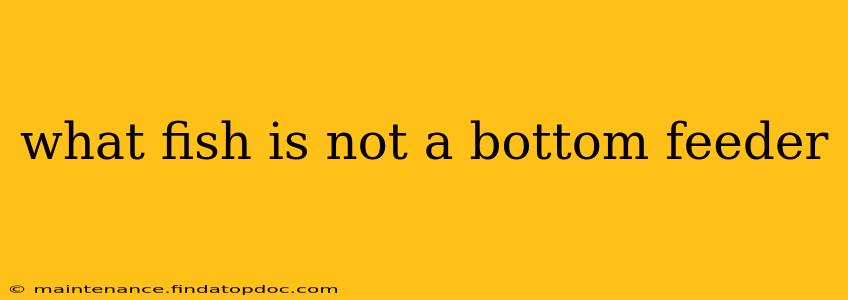What Fish is Not a Bottom Feeder? A Deep Dive into Fish Habitats
Many fish are known for their bottom-feeding habits, scavenging for food on the lake or ocean floor. However, a vast number of fish species inhabit different water columns and employ diverse feeding strategies. This article will explore various fish that are definitively not bottom feeders, highlighting their unique habitats and feeding behaviors. We'll also address some common questions surrounding fish habitats and feeding preferences.
What are some examples of fish that don't live on the bottom?
Numerous fish species avoid the benthic zone (the bottom of a body of water) and instead thrive in the pelagic zone (the open water). These fish often have adaptations suited to their specific habitat and feeding strategies. Here are some prime examples:
-
Tuna: These powerful, fast-swimming predators are pelagic fish, meaning they live and hunt in the open ocean, often in schools. They are ambush predators, feeding on smaller fish, squid, and crustaceans in the water column.
-
Salmon: While salmon spend part of their lives in rivers (often spawning in shallow, bottom areas), much of their adult lives are spent in the open ocean, feeding on smaller fish and crustaceans.
-
Sardines: These small, schooling fish are a crucial part of the marine food web. They are pelagic feeders, consuming plankton and other small organisms in the water column.
-
Herring: Similar to sardines, herring are pelagic schooling fish, feeding on plankton and small crustaceans in the upper layers of the ocean.
-
Flying Fish: These amazing creatures are pelagic and use their large pectoral fins to glide above the water, evading predators and hunting small prey in the surface waters.
-
Many reef fish: While some reef fish are bottom dwellers, many species inhabit the coral structure itself, feeding on plankton, smaller fish, or invertebrates within the reef’s complex ecosystem.
What types of fish are bottom feeders?
Understanding what isn't a bottom feeder often helps clarify what is. Common bottom feeders include:
- Catfish: Many catfish species are benthic, using their barbels (whiskers) to locate food on the bottom.
- Flounder: These flatfish lie camouflaged on the seabed, ambushing prey.
- Goby: Many goby species are bottom dwellers in various aquatic environments.
- Suckermouth Catfish: These fish are known for their sucker-like mouths, which they use to attach to surfaces and graze on algae and other organic matter.
How do I know if a fish is a bottom feeder?
Identifying a bottom feeder often comes down to observing its behavior and physical characteristics:
- Mouth Position: Bottom feeders often have downward-facing mouths, ideal for foraging on the substrate.
- Body Shape: Some bottom feeders have flattened bodies, allowing them to remain close to the bottom.
- Feeding Behavior: Observe the fish in its natural habitat; does it spend most of its time near the bottom?
Are there any exceptions to the "bottom feeder" rule?
Yes! Many fish exhibit opportunistic feeding behaviors. A fish typically considered a bottom feeder might occasionally feed in the water column, depending on food availability. The categorization is a general guideline, not an absolute rule.
What determines a fish's habitat?
A fish's habitat is determined by a complex interplay of factors, including:
- Food Availability: The presence of preferred food sources heavily influences habitat choice.
- Water Temperature: Different fish species thrive in different temperature ranges.
- Water Chemistry: Factors like salinity, oxygen levels, and pH all play crucial roles.
- Predator Avoidance: Habitat selection can be driven by the need to avoid predators.
- Reproductive Needs: Certain habitats may be necessary for spawning and rearing young.
In conclusion, while many fish are indeed bottom feeders, a significant number of species occupy different water columns and utilize diverse feeding strategies. Understanding these distinctions provides a deeper appreciation for the incredible diversity and complexity of aquatic ecosystems.
